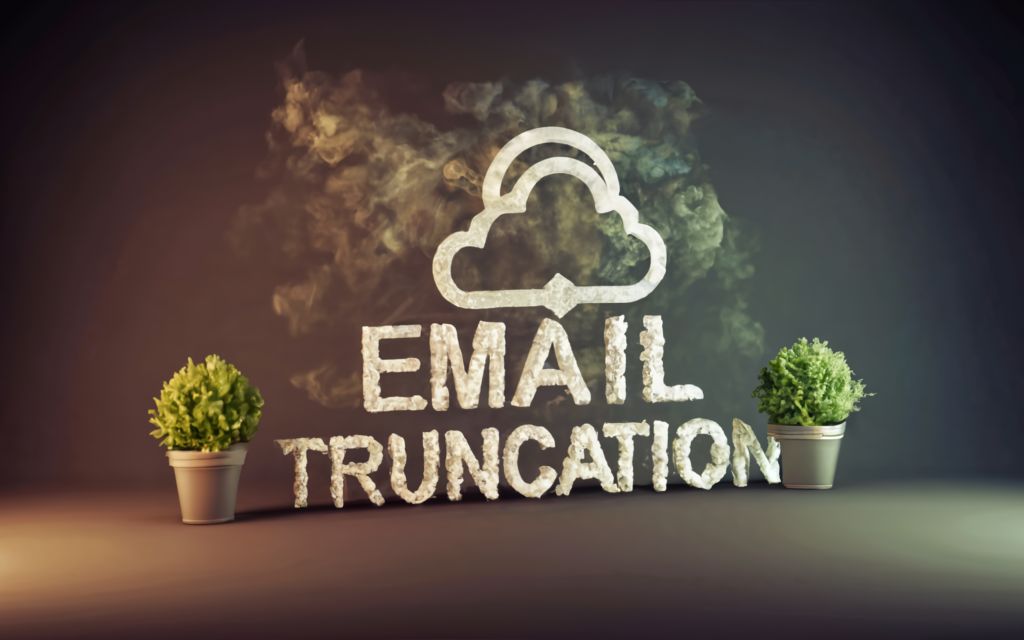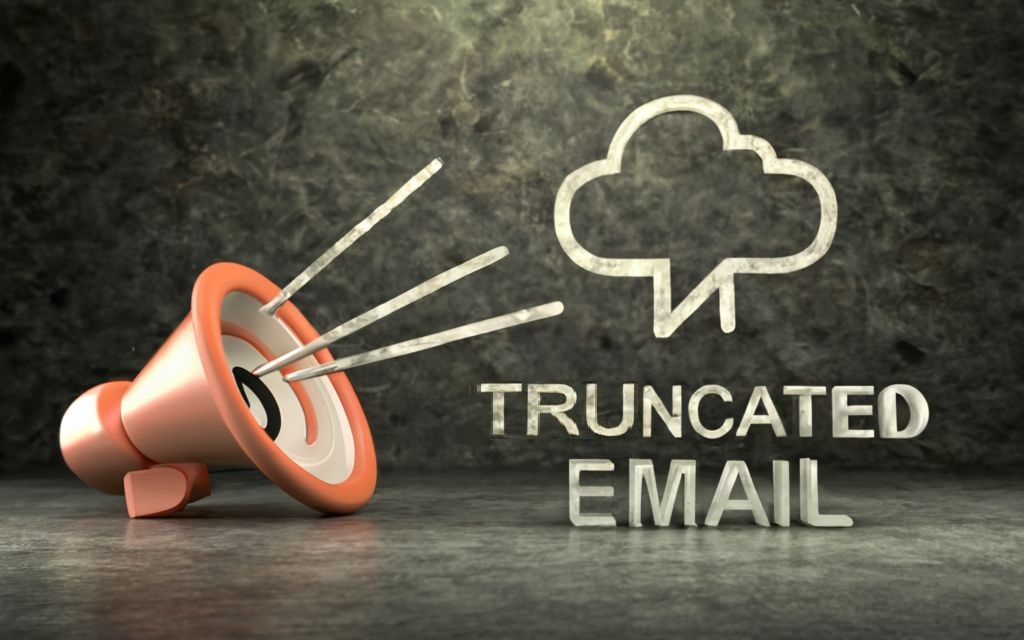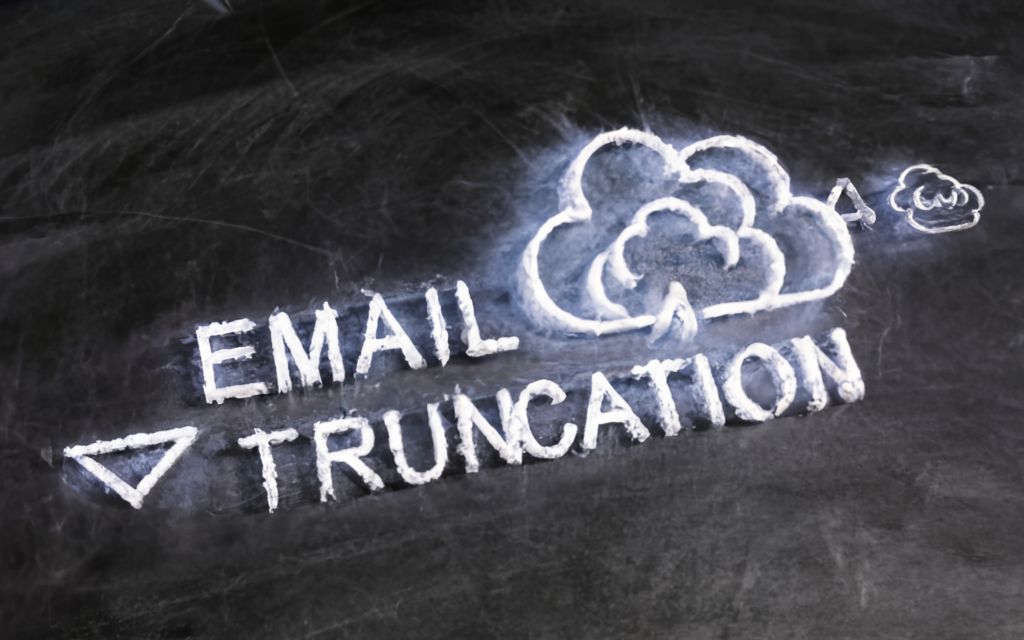Why does your inbox rudely chop emails like an impatient deli slicer? We’ve all seen that vexing “message truncated” notice. In this comprehensive guide, we’ll demystify what email truncation is, what causes it, how to recover lopped-off content, and most importantly – how to stop texts getting curtailed again. Virus blacklists, ESP anti-truncation features, VERP return paths, and more. Let’s finally solve the truncated email mystery, step-by-step!
What Does “Message Truncated” Mean?
We’ve all seen that dreaded “Message truncated” notice when opening an email. One minute you’re eagerly awaiting Aunt Bertha’s famous fruitcake recipe in your inbox, and the next minute you get five lines of text and an apologetic footnote from Gmail.
So what gives? Why does email truncation happen and what can be done about it? Let’s decode this common but confusing phenomenon.
At its core, email truncation simply means that some content from the original message has been automatically removed before delivery. Instead of receiving the email in its full, delicious entirety, you’re left with a partial preview and a bad taste in your mouth (or maybe that’s just the fruitcake).
Truncation happens for a variety of technical reasons having to do with email size limits on both the sender and recipient side. When an email exceeds the allowed data size, the mail server chops off the extra content to avoid rejections.
Think of it like trying to cram a king-sized mattress into a compact car trunk – parts are bound to get cut off if it doesn’t fit!
Different email providers have different truncation limits:
- Gmail typically truncates messages over 1 MB. Go easy on the attachments and images!
- Outlook caps email size at 35 MB for Office 365 accounts. Personal Outlook.com accounts limit messages to 25 MB.
- Yahoo Mail measures truncation by bytes rather than MB. Any message over 262,144 bytes will get chopped.
- iCloud maintains a generous max message size of 100 MB. Apple users, feel free to get verbose!
Of course, size limits alone don’t tell the whole story. The method of truncation also varies:
- Gmail is merciful, usually leaving emails intact up to 1 MB before replacing any excess with a “[Message clipped]” link.
- Outlook just cuts emails mid-sentence at the truncation limit, which I maintain is rude.
- Yahoo Mail extracts and preserves the first 262,144 bytes, but obliterates anything thereafter. Hope you front-loaded the important stuff!
So in summary: “Message truncated” is the kiss of death from your mail service, letting you know the email couldn’t fully make it through. Depending on the provider you use, oversized emails may get stubbornly sliced off or replaced by ominous clip notifications.
In any case, it means you’re missing out on potentially crucial details, like whether to put the maraschino cherries on top of Aunt Bertha’s fruitcake before or after glazing. Pro tip: ask before eating.
The reasons for truncation vary as well. Large file attachments and images are common culprits. In other cases, an overzealous sender may have crafted a novella-length message that exceeded size restrictions. Unfortunately for the recipient, sections are automatically sacrificed in the name of deliverability.
Luckily, better awareness of provider size limits and use of compression tools can help avoid the dreaded truncation scenario. We’ll unravel more truncation mysteries ahead, but first let’s get to the root causes of this email phenomenon.

Causes of Email Truncation
Alright, now that we know what truncated emails are, let’s dig into why this pesky phenomenon happens in the first place. There are a few key technical culprits that could be sabotaging your inbox:
Sender Size Limits
One of the most common reasons for email truncation is that the sender’s outgoing mail server has imposed a size limit on messages. Most email providers don’t allow infinitely large emails to be sent from their systems.
Limits may be set at the individual account level or applied universally across the email service. Here are some common sender size restrictions:
- Gmail caps message size at 25 MB for free accounts and up to 50 MB for paid G Suite accounts.
- Outlook.com maintains a limit of 25 MB per message sent.
- iCloud sets a generous but still finite limit of 100 MB per email.
- Yahoo Mail caps outgoing messages to 25 MB for standard accounts.
- Office 365 and hosted Exchange accounts may have customizable size limits starting at the default 35 MB.
If an email you’re composing exceeds your sender account’s permitted size, the service will automatically truncate the message before sending it out. This helps prevent rejections from the recipient’s server.
So if Aunt Bertha is an Outlook user including 20 MB of family photos in her frontloaded fruitcake manifesto, she may be bummed to discover only the first 10 megabytes make it to recipients.
Recipient Size Limits
Sending size isn’t the only restriction. Recipient servers also impose maximum allowable email sizes to protect their systems.
As we touched on earlier, different providers have different cut-off limits:
- Gmail caps incoming messages at 25 MB.
- Outlook.com also limits incoming email to 25 MB.
- iCloud generously accepts up to 100 MB.
- Yahoo Mail permits incoming emails up to 25 MB for free users and 1 GB for paid subscribers.
If an incoming message exceeds the recipient limit, the mail server will truncate the excess content to deliver the email.
So Aunt Bertha’s 50 MB masterpiece from her premium G Suite account might be trimmed down by Gmail before it reaches your measly 25 MB inbox limit. Darn you, Bertha!
Routing Through Multiple Servers
Here’s another opportunity for truncation to sneak in. Emails often pass through multiple mail servers as they travel from sender to recipient.
Your message starts out on your outgoing email server (say, Gmail’s servers). It’s then routed through your ISP’s mail servers, before arriving at the recipient’s mail servers (Outlook’s, for example), then maybe passing through the recipient’s own ISP’s servers before final delivery.
Each of these servers could have their own size limits configured. So even if your outgoing mail and the recipient’s incoming mail support 50 MB messages, truncation can still occur if an intermediary mail server has a 25 MB limit.
It’s like that giant SUV Bertha crammed her oversized mattress into hitting a tiny tunnel on the way to your house. Even if her driveway and yours could fit it, that squeezy tunnel turns the package into a pancake.
Getting Snagged by Spam Filters
Finally, truncation may occur when emails get caught in spam filters before reaching your inbox. Spam filters are on high alert for any signs of unwanted or dangerous email.
attaching large files, using certain words, sending from an unknown address, or other red flags for spam. A filtering service may truncate or quarantine messages deemed risky to prevent them from wreaking havoc in recipients’ inboxes.
Spam Filters and Blacklists
This brings us to the inner workings of spam protection. To truly solve the truncation troubles, we need to understand what exactly causes emails to be labeled as spam in the first place.
What is a Blacklist?
In the email security world, blacklists are lists of IP addresses or domains/servers that have been flagged as sources of spam. They function kind of like wanted posters in the Wild West.
Major email providers and anti-spam services maintain blacklists to block messages from untrustworthy senders. If your outgoing mail server IP is on a blacklist, your emails may be bounced, rejected, or truncated before ever reaching the recipient.
Major Email Blacklists
Some of the heavy hitters in the blacklist space include:
- Spamhaus – One of the longest running and most widely adopted blacklists, used by major ISPs and mail services. They identify spam sources through spam traps and bots.
- Spamcop – SpamCop builds blacklists based on user-submitted spam reports and maintains a point system leading to listings.
- Barracuda – Barracuda is a security company providing email filtering appliances relying in part on proprietary spam data.
- Sorbs – The Sorbs blacklist has been around since 1993 and shares data on open proxies/relays, spam malware, and harvested emails.
How Blacklists Flag IPs as Spam
Companies and services use a few common techniques to detect and blacklist spam senders:
- Honeypots/Spam traps – Fake email addresses are planted like traps to lure spammers. Any mail sent to them earns black marks.
- Spam reports – User complaints provide human insight into unwanted email. Too many strikes can trigger a blacklist.
- Activity thresholds – Heuristic monitoring around sending patterns (volume, frequency, etc) identifies potential abusers.
- Behavioral analysis – Machine learning models analyze past email sender habits to predict spammers.
- Email content – Spammy keywords, malformed headers, suspicious attachments etc also raise flags.
Too many shady signals, and boom – you’re blacklisted.
Checking if You’re Blacklisted
If you suspect truncation or deliverability issues are due to blacklisting, you can check your email domain or IP against major databases:
- MXToolbox lets you test against ~100 different blacklists: https://mxtoolbox.com/blacklists.aspx
- You can also search for a domain on the Spamhaus website directly.
Delisting steps vary based on the source, but often involve correcting any spammy activity and submitting removal requests.
Avoiding and Removing Blacklistings
Now the big question: How do well-meaning senders stay off blacklists in the first place?
Best Practices for Deliverability
- Proactively scan your lists and remove bounced/invalid emails to keep engagements high.
- Monitor complaints and opt-outs to identify any disengaged subscribers.
- Use double opt-in processes to ensure subscribers consent to emails.
- Warm up new IP addresses gradually to establish reputation.
- Ensure no hard bounces are generated that permanently ruin your domain’s standing.
Requesting Blacklist Delisting
If you do end up on a blacklist, here are tips for getting removed:
- Immediately stop any activity that triggered the blacklisting, whether spam reports or detected honeypot mailings.
- Search for direct delisting procedures on the blacklist provider’s site. For example, Spamhaus offers a removal request form.
- Contact your ISP for assistance – they can coordinate delisting requests and vouch for you.
- Be patient as it may take days or weeks to process whitelisting requests after corrective actions.
Using Whitelists
Another proactive tactic is getting on email whitelists – the yin to blacklists’ yang.
Whitelists are lists of approved senders deemed safe by major receiving domains and ISPs. Whitelisted domains bypass spam filters for smooth sailing.
- Sign up for services like ReturnPath Certification to get whitelisted.
- Develop direct relationships with partner recipient domains and ask to be added to their internal whitelists.
So in summary, truncation and spam filtering are interconnected challenges. Strategic deliverability planning and whitelisting can help avoid the blacklist and keep Aunt Bertha’s entire saga of fruitcake from hitting the cutting room floor.

Consequences of Truncated Emails
Alright, we’ve explored what causes the dreaded email truncation. Now let’s discuss why you should care when messages get chopped and the implications of ongoing truncation.
Loss of Message Content
This one’s obvious, but worth stating plainly: truncation leads to missing information. That detailed itinerary from your travel agent? Suddenly stops at the airline and cuts off the hotel confirmation. The report from your team with key metrics and insights? Chops off mid-summary before the recommendations.
Losing pieces of the content sender intended to convey is never ideal. At best, truncation causes minor annoyance. At worst, vital details are lost leading to confusion, poor decisions, or problems fulfilling the email’s purpose.
In Aunt Bertha’s case, you may miss out on key guidance like how long to bake the fruitcake for perfect doneness (not that there is such a thing).
Difficulty Associating Bounces
Here’s another frustrating side effect of truncation: delivery failures become harder to diagnose.
When an email bounces back due to an invalid address and the message is truncated, it’s extra tricky to tell which exact email the bounce relates to based on limited content. This makes keeping mailing lists clean a lot more painstaking.
Bounces are similarly hard to parse if unique identifiers like subject lines or VERP return paths pointing back to the original message get cut off. Analyzing email campaigns’ health becomes less accurate.
Reduced Deliverability When Repeated
The most serious risk of ongoing truncation is reduced deliverability and potential blocking if left unchecked.
As mentioned regarding blacklists, major ISPs and spam filters use various signals like reputation history and complaints to gauge trustworthiness. If a domain or IP address repeatedly sends truncated emails, it may get flagged as a potential spammer or blocked sender by spam filters.
Why would truncated content suggest spam? In some cases, spammers intentionally truncate messages to escape filters scanning email bodies. When truncation happens accidentally due to size limits, the effect is the same – content scanning is prevented. So repeated legitimate truncations can still damage sender reputation over time and trigger blocks.
The lesson here is that although occasional truncated emails are expected, chronic truncation indicates underlying issues that senders should fix to preserve deliverability.
Let’s say Aunt Bertha realized her mail server kept cutting off her magnum opus fruitcake instructions to you. If she failed to increase her size limits and continued chopping every message, eventually your inbox could start auto-filtering her emails as suspicious. A very sad fruitcake-less outcome!
Bottom Line
The bottom line is that truncation degrades the email experience for recipients, makes campaign analysis tough, and risks deliverability nightmares if left unaddressed.
While the odd truncated message is no cause for alarm, chronic truncation is a sign something needs fixing. Later we’ll explore specific solutions, but first let’s look at how to minimize future truncation incidents.
Solutions for Handling Truncated Emails
Alright, we’ve explored the truncation problem from all angles. Now let’s get to the good stuff – how can senders gracefully handle truncated emails and avoid losing vital details? There are both technical fixes and email service features that can help.
Using VERP Return Paths
One common technique is using Variable Envelope Return Paths (VERP). This method essentially tags each recipient with a custom return path for bounce messages.
Normally when an email bounces, the return path simply points at the general sending address. But with VERP, it also includes unique variables that let you identify the exact message and recipient it came from.
For example, return paths may look like:
When you receive bounce notifications, the custom VERP return path helps parse which recipient it relates to. This avoids the confusion of truncated bounces lacking context.
VERP requires configuring your mail server or provider to enable dynamically inserted and routed return paths. But it provides more informative bounces.
Adding Unique IDs to Subjects
If VERP isn’t an option, another technique is including unique identifiers in the subject line of each email.
Maybe recipient emails get tagged with a unique # like:
- Holiday Promo #A97Z42 for [email protected]
Or simpler sequential numbers:
- Holiday Promo 1 for [email protected]
- Holiday Promo 2 for [email protected]
That way if truncation occurs, you can still cross-reference bounces based on the recipient-specific subject line. Not as robust as VERP, but still helpful.
Automatically Resending Full Content
Certain email services offer automated resending if truncation is detected. Here’s how it works:
- Original full message is sent and truncation occurs.
- Upon truncation, service extracts and stores full content.
- Truncated email is delivered to recipient with a link to view the entire message.
- If the recipient clicks to view full content, service automatically redelivers the original stored email in its entirety.
This provides a smooth user experience and ensures recipients can still access complete content if they desire. It does come at the cost of additional storage and delivery fees.
Email Services With Anti-Truncation Features
The good news is many popular email providers and services now include automated protections and resending capabilities in case of truncation:
Gmail
- Replaces oversized email content with “[Message clipped]” links
- Allows recipients to click to view entire message
- Requires enabling by senders in settings
Outlook/Office 365
- “Read the full message” links for truncated emails
- Stores original full content for redelivery
- Controlled by administrator settings
Yahoo Mail
- Default truncation at 262,144 bytes
- Paid subscribers get full in-app view of oversized emails
SendGrid
- Automatically resends full content if truncation detected
- Handle up to 100 MB messages with segmentation
Mailgun
- Clickable links to retrieve full message copies
- API to customize truncation behavior
Amazon SES
- Access full message contents via S3 bucket
- Lambdas can reassemble segmented emails
Recommendations for High Volume Senders
For major email campaigns, key features to minimize truncation issues include:
- Link tracking to detect truncation when recipients click for full content
- Open and click analytics to optimize content length
- Custom truncated message footers to improve experience
- Automated reassembly and redelivery of complete messages
- Granular truncation settings to handle edge cases
In summary, there are now many effective techniques to handle the dreaded truncated email scenario. A combination of unique identifiers, intelligent resending, and service configurations can help you recover from truncation gracefully.

Preventing Future Email Truncation
Now that we’ve explored solutions for handling individual truncated emails, let’s talk prevention. What proactive steps can you take to avoid chronic truncation and protect deliverability going forward?
Optimizing Content Length
If truncation is happening consistently, first take a look at your email content itself. Are there opportunities to tighten it up without losing substance?
Some tips for optimizing length:
- Cut repetitive filler text – Avoid repeatedly explaining who you are or what your company does.
- Consolidate sections – See if any sections can be combined without losing key info.
- Shorten intros/signatures – Keep greetings and sign-offs concise.
- Trim descriptions – Tighten up explanatory passages and prose.
- Reduce image sizes – Scale down large images or compress file sizes.
- Simplify design – Limit styling elements that increase code bulk.
- Link out for more – Rather than embedding full content, link to your site.
- Limit attachments – Ask if attachments can be uploaded to a Dropbox vs. attaching.
Ideally keep emails under 100 KB, or up to 300 KB if required. That leaves plenty of wiggle room before major truncation limits are hit.
Warming Up New IPs
When onboarding new dedicated IPs for sending, properly warm them up over time rather than immediately blasting large volumes.
Gradual warm up builds positive reputation and avoids being flagged as spam. Take 2-4 weeks to ramp up new IPs to higher volumes.
Monitoring Blacklist Status
Keep a close eye on major email blacklists to avoid landing in spam filters, as discussed earlier.
Use a monitoring service like MXToolbox which checks your domain/IP against ~100 different blacklists.
If you find yourself added to any blacklists, follow the necessary steps to get removed ASAP to avoid prolonged delivery issues.
Additional Tips for Avoiding Truncation
Here are a few other recommended tips:
- Use compression – Zip attachments and compress images to reduce email footprint.
- Segment longer content – Break into multiple sequential emails if needed.
- Upgrade plans – Bump send limits by upgrading email service tiers if cost feasible.
- Switch providers – If yours lacks protection, shop providers with anti-truncation features.
- Analyze campaigns – Review analytics to pinpoint recipients/content causing truncation.
- Alert on truncation – Create email alerts to notify if an email is truncated.
- Get on whitelists – Actively get IPs and domains whitelisted with partners.
With a few simple precautions, you can contain truncation issues before they spiral out of control. The less you actually truncate, the better your domain’s send reputation will be over time.

Key Takeaways and Actions
We’ve covered a lot of ground explaining truncated emails. To wrap up, let’s recap the key takeaways and actions you can take to solve truncation woes.
Recap of Key Points
- Truncation definition – Email content removed automatically by mail services due to size limits.
- Causes – Sender limits, recipient limits, intermediary server limits, spam filters.
- Consequences – Information loss, unclear bounces, deliverability risks if ongoing.
- Avoidance – Optimize content, warm up IPs, monitor blacklists, use whitelists.
- Handling – VERP return paths, unique IDs, resending services, truncation notices.
- Prevention – Shorter emails, new IP warm up, blacklist monitoring, whitelisting.
Suggested Actions
If you’re dealing with chronic email truncation issues, here are some concrete next steps:
- Audit content length – Review email size averages and identify truncation triggers.
- Check blacklists – Monitor major blacklists regularly to avoid blocks.
- Enable resending – Configure your ESP to automatically resend full emails post-truncation.
- Add truncation alerts – Get notified when an email is truncated to stay ahead of problems.
- Warm up new IPs – Gradually ramp up volume when adding new dedicated IPs to build reputation.
- Get whitelisted – Request to be added to partner and ISP whitelists for deliverability.
- Try compression – Experiment with compressing images and attachments to optimize size.
- Upgrade if needed – Consider expanded delivery limits by upgrading to a higher tier account.
- Learn from analytics – Dig into your email analytics to pinpoint problematic recipient domains or content.
- Keep subject lines unique – Use tracking codes or sequential numbering to identify truncated bounces.
With focus on these areas, you can contain truncation and prevent it from continually eating your emails. Don’t let key details get lost in translation.
We’ve now explored truncated emails inside and out – the causes, consequences, solutions, and preventions. Hopefully you feel equipped to tame truncation in your email campaigns going forward. If fruitcake analogies weren’t enough, remember that reliable deliverability is the gift that keeps on giving.
Key Takeaways on Decoding Truncated Emails
Let’s recap the core lessons on identifying, fixing, and preventing truncated emails:
- Definition – “Message truncated” means an email was automatically shortened by mail services before delivery due to size limits.
- Causes – Common truncation triggers include sender limits, recipient limits, spam filters, and blacklists flagging emails as risky.
- Consequences – Lost message details, unclear bounce sources, and potential deliverability issues if ongoing.
- Avoidance – Optimize content length, properly warm up new IPs, monitor blacklist status, and request whitelisting.
- Handling – Use unique identifiers and resending services to recover full content post-truncation. Enable in provider settings.
- Prevention – Shorten emails when possible, analyze campaigns to pinpoint truncation causes, warm up new IPs gradually, and stay off blacklists.
- Technical Fixes – Implement VERP return paths and unique IDs like tracking codes to identify truncated bounce sources.
- Email Provider Features – Choose services with anti-truncation capabilities like automatic reassembly and redelivery of full messages.
With focus on these best practices, you can minimize truncation issues and their negative impacts. Keeping deliverability high and inboxes happy is the ultimate takeaway.
Frequently Asked Questions About Truncated Emails
Let’s cover some common truncated email questions:
What does “message truncated” mean?
It means parts of the original email have been automatically removed before delivery due to size limits, usually indicated by a notice added to the truncated message.
What causes email truncation?
Main causes are sender size limits, recipient inbox size limits, spam filters flagging emails as risky, and blacklisting of sender IPs. Going through multiple servers with different limits can also truncate.
Why do emails get truncated?
To avoid having emails rejected entirely by recipient servers, mail services preemptively truncate them if they detect messages exceeding allowed size limits.
Is truncation the same as email clipping?
Essentially yes – both refer to content being cut off, though clipping more vaguely refers to any form of editing or shortening content.
How can I avoid future email truncation?
Optimize email content length, warm up new IPs gradually, check blacklist status regularly, and request whitelisting. Upgrade plans if needed for higher size limits.
How do I recover full truncated email content?
Use unique identifiers and email services with automated reassembly features. Click redelivery links or configure services to store and resend full content.
How do I know an email was truncated?
Truncation notices like “message clipped”, links prompting you to view full content, or seeing emails cut mid-sentence indicate truncation.
Why is truncation bad for deliverability?
Ongoing truncation signals potential issues to spam filters and can damage sender reputation over time, eventually leading to blocks if unaddressed.
How can I tell which recipient an unclear bounce relates to?
Use unique identifiers like VERP return paths or custom codes in subject lines to tie bounces back to original recipients.
Let me know if you need any other common email truncation questions covered!

